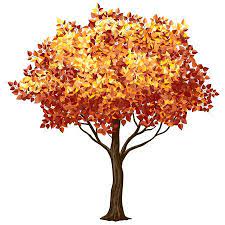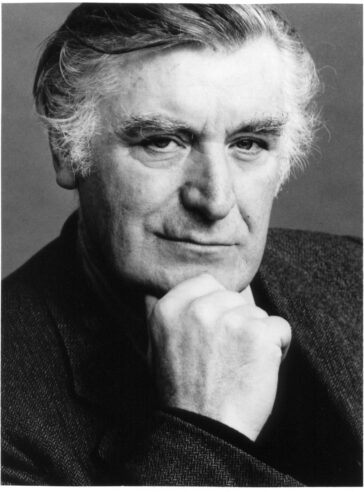Poem-2
The Laburnum Top
By Ted Hughes

The Laburnum Top Poem Introduction
Ted Hughes wrote the poem 'The Laburnum Top.' It's about a mutually beneficial relationship between a Laburnum tree and a Goldfinch bird. The tree is yellow, silent, and death-like, but it is brought to life by the bird and her young. The yellow bird makes her home in a tree, where she feeds her young. However, as soon as the bird leaves to fly in the sky, the tree returns to silence and death-like.
The Laburnum Top Poem Summary
The poem begins with a description of a Laburnum tree with a still and silent top. Its leaves had turned yellow, and its seeds had fallen to the ground. It was a day in September, and the tree was motionless and deathly still.
The arrival of the Goldfinch bird brings life to the lifeless tree. She came to feed her younger children, who are perched on the branch's thicket. Her safe haven is the tree. With a chirping sound, she reaches the end of the branch. She then moves to the other side of the branch with a lizard-like speed and caution. Her young ones begin chirping like a machine, vibrating, and flapping their wings as soon as she arrives. The death-like tree comes to life, trembling and shaking.
She flies to the other side of the branch after feeding them. As she vanished behind the yellow leaves, her dark-colored face and yellow body were barely visible. She flew away in the sky, leaving the tree lifeless once more.
The Laburnum Top Poem Explanation
The Laburnum top is silent, quite still
In the afternoon yellow September sunlight,
A few leaves yellowing, all its seeds fallen.
- Laburnum – a short tree with hanging branches, yellow flowers, and poisonous seeds
In the preceding lines, the poet describes seeing a yellow-leaved Laburnum tree. In the month of September, the top of the tree is still and silent. It's autumn, and all of the tree's seeds have fallen. The poet used the word "yellow" to describe leaves and sunlight. Yellow is associated with silence, death, and beauty. With this colour, he describes the entire scene of the tree.
Till the goldfinch comes, with a twitching chirrup
A suddenness, a startlement, at a branch end.
Then sleek as a lizard, and alert, and abrupt,
She enters the thickness, and a machine starts up
Of chitterlings, and a tremor of wings, and trillings —
The whole tree trembles and thrills.
- Goldfinch – a small singing birds with yellow feathers on its wings
- Twitching – sudden jerk movement
- Chirrup – a bird making repeated high pitched sounds
- Startlement – feeling or showing sudden shock
- Abrupt – rapid
- Chitterings – to make a chattering sound
- Tremor of wings – involuntary vibration of the wings
- Trillings – to produce a chirruping sound
- Trembles – to shake
- Thrills – a sudden feeling of excitement
A Goldfinch bird appears and makes a sudden chirrup sound, bringing the tree's death-like scene to an end. The bird sits on the tree's branches, being as quick, alert, and cautious as a lizard. As she moved closer to the branch's thicket, her young ones began chirruping and making machine-like vibrations with their wings. The tree begins to shake and thrill as a result of the movement of the bird and her young. The tree has been depicted in two opposing scenarios by the poet. The tree was death-like and still at first, but then it gave life and shelter to the bird and her young ones.
It is the engine of her family.
She stokes it full, then flirts out to a branch-end
Showing her barred face identity mask
- Flirts out – lead on to
- Stokes – to add fuel to the engine
- Barred – stripy
Her family's engine is the Laburnum tree and the goldfinch bird. She feeds her young and moves to the opposite branch end. Her dark-colored striped face is visible because her body is yellow and she hides behind the tree's yellow leaves.
Then with eerie delicate whistle-chirrup whisperings
She launches away, towards the infinite
And the laburnum subsides to empty.
- Eerie – weird and strange
- Whistle-chirrup – gentle whisper like the chirping of the bird
- Subsides – diminishes
When the bird reaches the end of the branch, it makes a sweet chirping sound similar to whispering and flies away into the infinite sky. It renders the Laburnum tree silent and death-like once more.
The Laburnum Top Poem Literary Devices
1. Alliteration – repetition of a consonant sound at the beginning of two or more consecutive words. The instances of alliteration in the poem are as follows-
September sunlight
tree trembles
2. Simile – comparison between two things using like or as.
Sleek as a lizard
3. Metaphor – an indirect comparison between two things. Generally, a quality is compared.
“She enters the thickness, and a machine starts up” – the noise created by the movement of the birds is compared to the machine’s noise
“It is the engine of her family.”
“Showing her barred face identity mask”
4. Personification – the attribution of personal nature characteristics to something non-human
The whole tree trembles and thrills.
5. Transferred Epithet – the figure of speech where the adverb is transferred to another noun
her barred face identity mask
About the Poet

Ted Hughes, pen name of Edward J. Hughes, (born August 17, 1930 in Mytholmroyd, Yorkshire, England—died October 28, 1998 in London), English poet whose most distinctive verse is devoid of sentimentality, emphasising the cunning and savagery of animal life in harsh, sometimes disjunctive lines.

 PathSet Publications
PathSet Publications
 ACERISE INDIA
ACERISE INDIA
